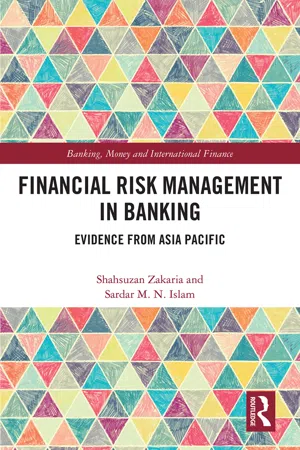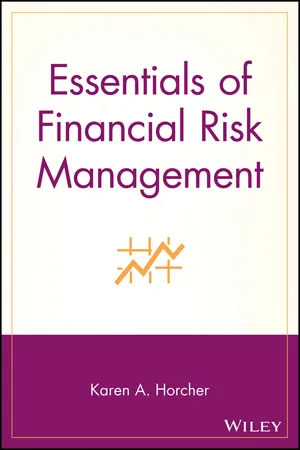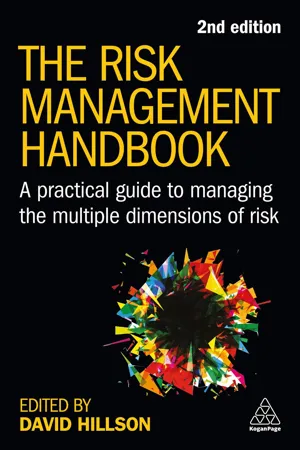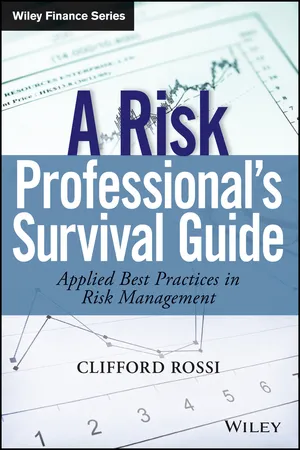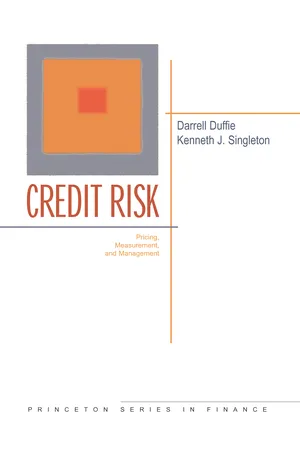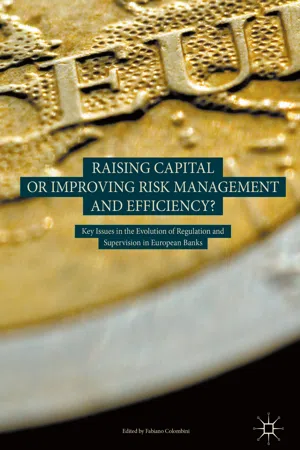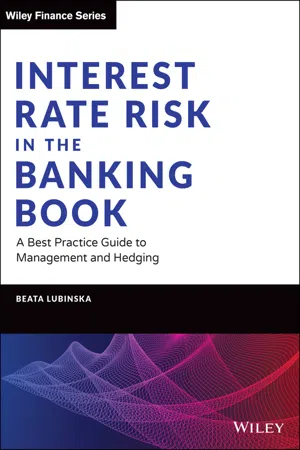Economics
Interest Rate Risk Management
Interest rate risk management involves strategies and techniques used by financial institutions and investors to mitigate the potential negative impact of interest rate fluctuations on their investments and financial positions. This can include using derivatives, diversifying investment portfolios, and implementing hedging strategies to protect against adverse interest rate movements. Effective interest rate risk management is crucial for maintaining financial stability and minimizing potential losses.
Written by Perlego with AI-assistance
Related key terms
11 Key excerpts on "Interest Rate Risk Management"
- eBook - ePub
Financial Risk Management in Banking
Evidence from Asia Pacific
- Shahsuzan Zakaria, Sardar Islam(Authors)
- 2019(Publication Date)
- Routledge(Publisher)
A bank is defined as an organisation that is empowered with cash and receives demand deposits of money and grants them as loans to different categories of borrowers or third parties, as well as investing in securities (Hubbard et al. 2002; Kashyap et al. 2002).Banks deal with risky conditions as they are constantly exposed to uncertainties which may adversely affect their profitability (Bessis 2011; McNeil et al. 2010; Kupper 2000). For example, changes in interest rate can significantly alter a bank’s profitability and the market value of its equity. In the banking environment, risk often refers to the impact of market focussing on the changes in the macro effects or volatility of market value, also known as the financial risk (Bessis 2011; Kupper 2000). Managers seek to balance the risk inherent in investments against the potential for profits (Bartesaghi et al. 2012).In the banking atmosphere, interest rate risk is often referred to as a negative impact of the economics of banking and on financial statements through assets and liabilities (Scannella and Bennardo 2013; Hassan and Bashir 2003), and it can be substantial (Bank for International Settlements (BIS) 2003). This justifies a focus on analysis which highlights the importance of interest rate risk for this research. Most scholars believe that interest rate risk has an impact on the overall earnings and can create outright losses threatening the financial stability of institutions (Drehmann et al. 2008; Fraser et al. 2002; Saunders and Schumacher 2000; Madura and Zarruk 1995). Therefore, risk management policies and procedures that limit and control interest rate risk are crucial in the risk management of banks (Greuning and Bratanovic 1999).2.2.1.1 Interest rate risk
Although there are many types of major risks including credit risk and liquidity risk, faced by banks, in considering the financial environment, this review will focus on interest rate risks which will appear repeatedly throughout the literature review (e.g. Delis and Kouretas 2011; Maddaloni and Peydró 2011; Elsinger et al. 2006; Brewer et al. 2001; Hirtle 1997). This emphasis is imperative since interest rate is non-diversifiable and banks naturally are repositories of interest rate risk (Gorton and Rosen 1995). Literally, this type of risk is related to a decline in earnings due to the movements of interest rates and also connected to potential movements in the volatility of bond yields (Viceira 2012; Jorion 2003). In an open market, the volatility of bond prices moves inversely with interest rates. This relationship is depicted by the formula used for fixed-income (FI) securities valuation, as shown below: - eBook - ePub
Banking and Financial Markets
How Banks and Financial Technology Are Reshaping Financial Markets
- Andrada Bilan, Hans Degryse, Kuchulain O’Flynn, Steven Ongena(Authors)
- 2019(Publication Date)
- Palgrave Macmillan(Publisher)
Further, there is heterogeneity in banks’ exposure to interest rate risk with some banks benefiting from an increase in interest rates, which creates a redistributive effect of monetary policy within the banking industry (Hoffmann et al. 2018). The literature further shows that banks do indeed use interest rate derivatives to manage their on-balance sheet exposure and that the extent to which they hedge depends on bank characteristics and derivative market conditions (Purnanandam 2007 ; Esposito et al. 2015 ; Hoffmann et al. 2018). Finally, the literature finds that a bank’s decision to manage and method of managing interest rate risk affects the transmission of monetary policy (Purnanandam 2007 ; Gomez et al. 2016 ; Hoffmann et al. 2018), the value of its equity (Flannery and James 1984b ; English et al. 2018), its lending behaviour, and, hence, the investment and employment decisions of the firms to which they lend (Gomez et al. 2016). The remainder of this chapter is organized as follows: we begin by reviewing the data sources and methodologies employed in the interest rate risk in banking literature. We continue by discussing the literature that seeks to uncover the following: (1) If and why banks are exposed to interest rate risk. (2) How and why banks manage interest rate risk. (3) What the consequences are of banks’ decision to manage interest rate risk for the transmission of monetary policy and for the firms to which they lend. 3.1 Data To conduct an analysis on bank’s interest rate risk exposure, researchers need to estimate the degree to which banks are affected by changes in the interest rate. To do this, researchers need detailed information on the maturity of banks’ assets and liabilities. A common measure for banks’ on-balance sheet interest rate exposure is the income gap, that is, the difference between the bank’s assets that mature (or reprice) within a year and its liabilities that mature (or reprice) within a year - eBook - ePub
- Karen A. Horcher(Author)
- 2011(Publication Date)
- Wiley(Publisher)
CHAPTER 1 What Is Financial Risk Management?After reading this chapter you will be able to- Describe the financial risk management process
- Identify key factors that affect interest rates, exchange rates, and commodity prices
- Appreciate the impact of history on financial markets
Although financial risk has increased significantly in recent years, risk and risk management are not contemporary issues. The result of increasingly global markets is that risk may originate with events thousands of miles away that have nothing to do with the domestic market. Information is available instantaneously, which means that change, and subsequent market reactions, occur very quickly.The economic climate and markets can be affected very quickly by changes in exchange rates, interest rates, and commodity prices. Counterparties can rapidly become problematic. As a result, it is important to ensure financial risks are identified and managed appropriately. Preparation is a key component of risk management.What Is Risk?Risk provides the basis for opportunity. The terms risk and exposure have subtle differences in their meaning. Risk refers to the probability of loss, while exposure is the possibility of loss, although they are often used interchangeably. Risk arises as a result of exposure.Exposure to financial markets affects most organizations, either directly or indirectly. When an organization has financial market exposure, there is a possibility of loss but also an opportunity for gain or profit. Financial market exposure may provide strategic or competitive benefits.Risk is the likelihood of losses resulting from events such as changes in market prices. Events with a low probability of occurring, but that may result in a high loss, are particularly troublesome because they are often not anticipated. Put another way, risk is the probable variability of returns. - eBook - ePub
Managing the New Bank Technology
An Executive Blueprint for the Future
- Marilyn R. Seymann(Author)
- 2020(Publication Date)
- Routledge(Publisher)
There are two ways accounting can impact a bank's ability to achieve its business goals: (1) misinterpretation and/or misapplication of accounting rules, with subsequent reversals and/or corrections; and (2) changes in accounting standards. An excellent example of the latter risk is SFAS No. 115, which resulted in a complete shift in the accounting treatment of certain investments in debt and equity securities for major institutional investors such as banks and insurance companies. Historically these institutions held these assets at book value. The implications of the shift to market-value accounting for certain of these assets had a potentially significant impact on earnings and portfolio management strategies.Taxation
Taxation presents potential risks similar to those found in the accounting area—the potential for misinterpretation and/or misapplication of existing tax rules and the possibility of unfavorable changes in the tax rules. As an example of the first risk, we need only look to the hedging rules that were in place at the time large institutions became involved in the use of financial derivatives. At that time the IRS definition of hedging was much more narrowly defined than was the definition in economic and financial practice. So a transaction which provided a real reduction in risk and was a hedge in the economic sense had the potential to expose a company to significant financial risk if the IRS disallowed the transaction under its more narrow definition. Another example was seen in the debate around "Arkansas Best" in 1993-94.RISK MEASUREMENT FOR BANKS
As interest rates have become more volatile, and banks have taken on more and more market exposure through their proprietary trading and derivatives activities, interest rate risk has become the number one concern of managers and regulators alike. Virtually all of the key businesses experience some degree of interest rate sensitivity in both assets and liabilities. The fallout of this is that risk management activities and tools have been largely focused on interest sensitivity. However, it is critical to remember that interest rate sensitivity is only one risk and that good risk management practice needs to be more comprehensive.The Technology—The Risk Management Delivery System
The process of selecting technology is well documented and available in other places.7 In general, the process should incorporate the following steps:7 . For example, The Handbook of Investment Technology, - eBook - ePub
The Risk Management Handbook
A Practical Guide to Managing the Multiple Dimensions of Risk
- David Hillson, David Hillson(Authors)
- 2023(Publication Date)
- Kogan Page(Publisher)
The techniques that banks use to manage risk are also applicable to all organizations. This is discussed below for non-financial companies in the section ‘How is financial risk managed?’.What is financial risk management?
Financial risk management is about identifying and mitigating the risks which attach to financial contracts such as deposits, credit, loans, insurance or other contracts. It differs from generic risk management in that:- the exposure is not a physical threat of loss or damage;
- it lends itself more easily to quantification; and because of this
- is more capable of being mitigated through some form of risk financing option;
- this ability to transfer risk may provide mitigation to individual entities, but introduces ‘systemic’ risk across whole sectors if not governed through regulation.
Clearly the above description lends itself closely to banks or other FIs, but most organizations have a capital base, bank accounts, enter into contracts and purchase insurance in some form. To that extent this section will provide insight to everyone, if it only enhances the understanding of what motivates banks or other FIs to act in certain ways.In distinguishing financial risk from ‘physical’ risk, it should be noted that fraud is not a physical risk in that it relies upon deception as opposed to removal by forcible theft. The risk of fraud and similar ‘internal’ types of risk stemming from organizational activity is discussed in Chapter 4 , operational risk management.The importance of capital
The first, and probably most important, concept in financial risk management is to understand the importance of capital - eBook - ePub
A Risk Professional�s Survival Guide
Applied Best Practices in Risk Management
- Clifford Rossi(Author)
- 2014(Publication Date)
- Wiley(Publisher)
CHAPTER 2 Overview of Financial Risk ManagementRISK MANAGEMENT DEFINED
Risk management describes a collection of activities to identify, measure, and ultimately manage a set of risks. People and organizations confront risks every day: For example, an individual decides to leave a relatively secure job for another with better opportunity and compensation across country, a government faces the threat of terrorist attacks on public transportation, or a bank determines which financial products it should offer to customers. While some risks are fairly mundane and others a matter of life or death at times, the fundamental process for assessing risk entails evaluation of trade-offs of outcomes depending on the course of action taken. The complexity of the risk assessment is a function of the potential impact from a particular set of outcomes; the individual deciding to take a different job is likely to engage in a simpler risk assessment, perhaps drawing up a pros and cons template, while a government facing terrorist threats might establish a rigorous set of quantitative and surveillance tools to gather intelligence and assign likelihoods and possible effects to a range of outcomes.Regardless of the application or circumstance, each of the assessments above has a common thread, namely, the assessment of risk. But what exactly is risk and is it the same across all of these situations? Risk is fundamentally about quantifying the unknown. Uncertainty by its very nature tends to complicate our thinking about risk because we cannot touch or see it although it is all around us. As human beings have advanced in their application of technology and science to problem solving, a natural evolution to assessing risk using such capabilities has taken place over time. Quantifying uncertainty has taken the discipline of institutional risk management to a new level over the past few decades with the acceleration in computing hardware and software and analytical techniques. - eBook - ePub
Princeton Series in Finance
Pricing, Measurement, and Management
- Darrell Duffie, Kenneth J. Singleton(Authors)
- 2012(Publication Date)
- Princeton University Press(Publisher)
2
Economic Principles of Risk Management
WHY DO MANAGERS of financial institutions care about financial risks? Are the economic incentives for managing market and credit risks the same, or does credit risk present different challenges, calling for distinct measurement systems or tools? These are some of the questions that we begin to address in this chapter. The economics of risk management for financial firms is far from an exact science. While rigorous and empirically testable models can be brought to the task of measuring financial risks, some of the benefits and costs of bearing these risks are difficult to quantify.In a hypothetical world of perfect capital markets—as we know from the work of Modigliani and Miller (1958), widely held to be the basis for the Nobel prizes awarded to Franco Modigliani and Merton Miller—any purely financial transaction by a publicly traded firm has no impact on that firm’s total market value. Capital markets, however, are not perfect. Market imperfections underlie significant benefits for banks and other financial institutions for bearing and controlling financial risks. Indeed, we name and characterize many of these benefits. One should not, however, anticipate a model allowing a practical cost-benefit analysis of risk that leads to precise quantitative trade-offs. Some of the important channels through which risk operates to the detriment or benefit of a financial corporation are not readily priced in the market.For instance, there are no obvious formulas to determine the market value that can be created by a financial firm willing to bear a given amount of risk through proprietary trading or intermediation. In perfect capital markets, after all, securities are priced at their fair market values, and trading could therefore neither add nor subtract market value. Any such formula relating financial risk bearing to the market value of the firm would, in the reality of imperfect capital markets, depend on such difficult-to-capture variables as the human abilities of traders and management, the information flows available to the firm, its reputation, its access to customers, and its organization of the risk-management function itself, not to mention a host of economic variables that characterize its economic environment. - eBook - ePub
The Bank Credit Analysis Handbook
A Guide for Analysts, Bankers and Investors
- Jonathan Golin, Philippe Delhaise(Authors)
- 2013(Publication Date)
- Wiley(Publisher)
In contrast to the banking book, balance sheet items that are utilized primarily for trading purposes including debt securities, repo finance, and similar instruments—the trading book—are managed in a somewhat different manner. The risk management of the trading book is characterized by the use of mark-to-market accounting and risk quantification methodologies, and, since the mid-1990s, VaR methodologies. Risk management of both usually involves the establishment of formal risk exposure limits and appropriate risk monitoring and reporting.Note that the distinction also affects the way latent profit or losses are accounted for.Asset Liability Management (ALM)
Banks are by nature transforming money, in that it is near impossible for them to match the maturities of their assets and liabilities. The pursuit of advantage through asset/liability mismatches and interest rate differentials is at the heart of banking and of the quest for greater profitability. Unexpected or abrupt changes in interest rates, however, can have an adverse impact upon a bank that has taken positions, or has received them through fresh customer or counterparty transactions, later found to be incorrect, or without adequate hedging. The bank’s funding costs may rise, resulting in a squeeze in margins. Consequently, there has long been recognition of the importance of identifying and managing interest rate risk in respect to the banking book. Not only may profits be affected by changes in interest rates, but liquidity may constrain the institution’s ability to access necessary funding. In a worst-case scenario, this could threaten the survival of the bank. For the latter reason, asset liability management (ALM) was introduced in Chapter 10 concerning liquidity.60In addition to its use in the context of liquidity risk management, ALM constitutes the traditional form of market risk management with respect to the banking book, and remains an indispensable part of modern banking operations. It encompasses a broad range of bank activities, including the identification of imbalances between earning assets and funding liabilities, on the one hand, and the formulation and implementation of strategies to mitigate or ameliorate identified risks, on the other. Responsibility for these matters lies with a bank’s asset liability committee or ALCO. - eBook - ePub
Raising Capital or Improving Risk Management and Efficiency?
Key Issues in the Evolution of Regulation and Supervision in European Banks
- Fabiano Colombini, Fabiano Colombini(Authors)
- 2018(Publication Date)
- Palgrave Macmillan(Publisher)
derivatives which, despite their origins that date a number of years, still find wide use in the banking world of today. Their diffusion has been, to say the least, very impressive, as attested by the growth of the markets of reference.As well as being used for a range of purposes, the aforementioned financial instruments play a key role in covering risks, there being several hedging techniques in use. In a bank context in which risk management represents the heart of all existing business areas, derivatives find an almost natural collocation, to the point that their use has become an almost everyday procedure. Thus banks adopt risk management policies which allow them to carry on their risk-taking function over financial markets and, at the same time, to use these financial instruments to reduce their risk exposure.Hence the need for adequate management skills to prevent negative outcomes related to experimentation with derivatives, because the ratio of assets to capital as is generally the case in the financial sector, will be very high. This implies measurement of the leverage, including fears of excess hedging, which may in the end result in pursuing objectives that do not genuinely constitute hedging but are better described as speculation, thereby increasing rather than reducing the range of risks.2.2 Risk and Bank
Risk identification, measurement and management represent the heart of bank enterprises, and the ability to control these aspects in a situation of asymmetric information is a fundamental bank function for the attainment of management results (Colombini, 2008 ; Colombini & Calabrò, 2011 - eBook - ePub
Interest Rate Risk in the Banking Book
A Best Practice Guide to Management and Hedging
- Beata Lubinska(Author)
- 2021(Publication Date)
- Wiley(Publisher)
Chapter 5 Interest rate risk and asset liability management MANAGEMENT OF IRRBB UNDER STRATEGIC ALM – PROACTIVE MANAGEMENT OF IRRBB This section is the most crucial in this book. It focuses on the proactive management of interest rate risk which means optimisation of hedging strategy achieved through the multi‐dimensional exercise, and the integrated management of different aspects – such as the liquidity profile of a bank, its IRRBB exposure, position on the interest rate curve, diversification of funding sources and avoidance of maturity cliffs – provides the quantifiable savings in terms of funding cost. This book proposes the adoption of a proactive approach for the funding plan strategy setting. The proportions of funding sources are precisely calibrated in order to reduce hedging expenses (and costs of hedge accounting designation) and, at the same time, to reduce the cost of funding. The funding tenor and proportions are driven by growth on the asset side and its financial characteristics. It means that funding strategy is not a silo basis exercise. It is a proactive and sophisticated process which brings both aspects together, i.e., hedging based on the projected growth on the asset side and reduction in the overall funding cost. Additionally, there is a description of both directional gap strategy on the short end of the interest rate curve (usually up to 12 months), natural hedging strategy and residual gap hedging strategy on the medium‐to‐long part of the curve. The second part of this section is dedicated to the strategic Funds Transfer Pricing (strategic FTP) which works as a tool to achieve the target profile of the bank. The words “strategic” and “optimised” are heard even more frequently in the aftermath of the financial crisis, the introduction of negative rates and onerous regulatory landscape - eBook - ePub
The Strategic Treasurer
A Partnership for Corporate Growth
- Craig A. Jeffery(Author)
- 2009(Publication Date)
- Wiley(Publisher)
Most important, financial risk management requires at the forefront a complete understanding of the risks the company is exposed to, and, just as important, management’s risk preference. A complete risk management process cannot stand on its own without the strength of each leg. Think of risk management in terms of a complete framework of economics, controls, and accounting: • Develop a robust risk management framework. • Identify your exposures; understand your risks. • Understand risk appetite, capacity, and tolerance. • Determine alternatives for dealing with risks. • Outline hedging objectives. • Communicate objectives and strategy to senior management and/or board. • Demonstrate the value of hedging. • Focus on the portfolio of risks. • Partner with your accounting group. • Be prepared for a Black Swan — have an action plan! • Measure performance. • Communicate. • Adapt and revise as needed. • Avoid the pitfalls of others (see Exhibit 10.8). EXHIBIT 10.8 Risk Management Pitfalls to Avoid It appears that companies need to be burned once or twice before they begin to believe in the value of hedging. Don’t let others’ Potential Reasons for Not Hedging (Exhibit 10.9) provide you with any excuses not to get started right away. EXHIBIT 10.9 Top Potential Reasons for Not Hedging Notes 1 Greg Krissek, “Effective Risk Management Programs for Fuel Ethanol Plants Charting an Unpredictable Future,” American Coalition for Ethanol, 2006 Annual Meeting, August 9, 2006. 2 Robert Cooper, “Guide to Risk Management,” The Treasurer’s Handbook 2005 (London: The Association of Corporate Treasurers, 2005), pp. 161-167. 3 Philip Potter, “Formulas and Numerics: Stochastic on the Street,” Financial Engineering News, No. 50 (July/Aug. 2006). 4 Richard A. Brealey and Stewart C. Myers, Principles of Corporate Finance. Fourth Edition (New York: McGraw-Hill, 1991), pp
Index pages curate the most relevant extracts from our library of academic textbooks. They’ve been created using an in-house natural language model (NLM), each adding context and meaning to key research topics.
